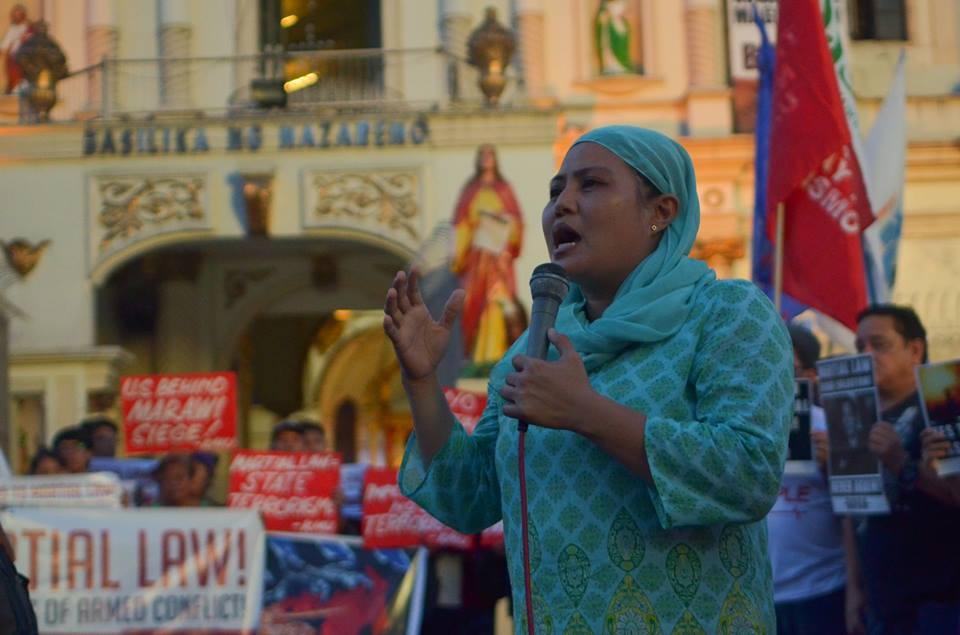
By AIRA MARIE SIGUENZA
Bulatlat.com
MANILA – Fifty-five years ago, under the dictatorship of Ferdinand Marcos Sr., at least 23 young Moros were killed in one of the most gruesome massacres in the country’s recent history – the Jabidah Massacre.
“We are commemorating [the Jabidah Massacre] this March 18, especially now that there is ongoing historical revisionism in school curriculums. It is saddening that there are movements today that aim to erase history,” said Amirah Lidasan of Sandugo – Movement of Moro and Indigenous Peoples for Self-Determination.
The Jabidah Massacre was among those that sparked the Moro liberation movement in the country. On March 18, 1968, about 23 to 28 young Moro recruits were gunned down by their military trainers in Corregidor Island, Manila after they complained about the harsh training conditions there.
Last weekend, which also marked the celebration of the Bangsamoro Freedom Day, groups Sandugo Movement of Moro and Indigenous Peoples for Self-Determination and Moro-Christian Peoples Alliance, Bai Indigenous Women’s Network, Katribu Kalipunan ng Katutubong Mamamayan ng Pilipinas, Research and Extension for Development Office (REDO), College of Social Work and Community Development – University of the Philippines Diliman, and UP Diliman Gender Office commemorated the bloody Jabidah Massacre and the women’s role in the liberation movement.
“This event is not different from what is happening in the present time. Marcos Sr. started deception and repression that led to massacres that are still occurring even now,” Kakay Tolentino from BAI IP Women’s Network stated.
Operation Merdeka
A special military unit named Jabidah was created to take part in the Oplan Merdeka, which was reportedly among the Marcos Sr.’s plan to destabilize and reclaim Sabah.
From August to December 1967, the Philippine Army led by Maj. Eduardo Martelino trained at least 200 young Tausug and Sama young men, with ages ranging from 18 to 30, in Camp Sofia in Simunul, Tawi-Tawi, The trainees were promised that they would be part of the Philippine Army and would be given high-powered firearms and a P50 ($0.91) pay per month to entice them to join.
Watch: This Week in People’s History: Jabidah Massacre
Read: Jabidah Massacre | Moro leaders stress need to unite and continue struggle
In December of the same year, around 135 to 180 recruits boarded a Philippine Navy vessel bound for Corregidor, where they turned an abandoned hospital into military barracks.
During their stay in Corregidor, the recruits noticed unfair treatment against the Tausug trainees as military officers lived comfortably in a hotel along Manila Bay.
“We received not a centavo. We were fed dried fish, and for coffee, we would use rice leftovers. The commanders were living in luxury, while we were living with almost nothing at all,” Jibin Arula, the lone survivor in the massacre, recounted in an article posted by the Bangsamoro Information Office.
More than 60 trainees then wrote a petition addressed to Marcos Sr. complaining about the maltreatment and false promises. Instead of addressing it, military officers promised to bring them home but were instead shot on March 18, 1968.
Arula, in his account, said he witnessed this and immediately ran to the mountain and jumped off a cliff. In the morning, he was rescued by two fisherfolk on Caballo Island and lived to tell the tale.
Historical atrocities against the Moro community
For the Moro people, however, the Jabidah Massacre was just one of the atrocities committed against them that remains unaccounted for.
Almost three years after the Jabidah Massacre took place, 70 Moro Muslims, including women and children, were mass murdered in a mosque in Manili, Carmen, North Cotabato, tagged as the Manili massacre.
While the Muslim residents gathered in the mosque for a supposed meeting with Christian groups, armed men bolted inside, insisting that the residents had firearms. After a while, the armed men started shooting and throwing grenades at the people.
On the other hand, on Sept. 24, 1974, the Palimbang Massacre happened, killing about 1,500 Moro men and women by military and paramilitary forces, according to the Transitional Justice and Reconciliation Commission (TJRC).
“[One hundred] heavily armed men entered a small village and razed it to the ground. Men, women, children and the elderly were tortured and murdered. Over 300 hundred houses were burned, women were raped, and men made to dig their own graves before they were shot,” said the Commission on Human Rights (CHR) in a statement.
However, it was only in 2014 that the government finally recognize the Moro residents killed in the massacre and provide compensation for them, said the CHR.
Last 2018, former Senator Juan Ponce Enrile, during the tête-à-tête titled “JPE: A Witness to History” with President Ferdinand “Bongbong” Marcos Jr., claimed that the gruesome killings were only invented by Governor Delfin N. Montano and Ninoy Aquino, who undertook a probe regarding the issue.
Read: #NoMoreMarcos | ‘Moros were killed like chickens during Martial Law’
“Enrile’s delusional claim that no massacres, not even the Jabidah massacre, happened was a treacherous lie intended to erase from our memory the murderous ways of Marcos’ martial law and in a way, absolve him of his crimes as the architect of martial law,” Jerome Succor Aba, speaking for Suara Bangsamoro, said in a statement.
Bangsamoro women’s role in the struggle
During the forum, the Moro community and fellow advocates also paid tribute to the courage and the continuing fight of the Bangsamoro women for liberation and self-determination.
“It was engraved in the minds of Muslim women that they are only for domestic chores. But we disagree. We help them understand that we are more than that,” said Ameerah Ibrahim, a Bangsamoro woman leader and a barangay councilor in Culiat, Quezon City.
Ibrahim also witnessed the Palimbang massacre as a child, and saw how women were raped and abused during the time. “I saw how the livelihood of the Moro people was damaged – the Army burned the people’s source of income and houses.”
This has pushed her to fight for women’s rights, as she joined the human rights alliance Karapatan.
From 2007 to 2020, she organized several Muslim women’s associations in her barangay, including the Filipino Muslim Movement of Economic and Society Development, the United Tribal Women’s Association, and the Muslima Iranon Women’s Association.
Gert Libang of women’s group Gabriela said she also witnessed how Moro women at the height of Marcos Sr.’s dictatorship in 1975 had a vital role in helping the Moro National Liberation Front (MNLF) by giving them food, welcoming them in their houses, and treating wounded Moro soldiers.
“When we did our research in 1994, we met a female warrior in Maguindanao and she shared how the Moro women took part in the battle. There are many Bangsamoro women who deserve tribute just like the heroines from the Spaniard colonization,” said Libang. (JJE, RVO) ![]()




